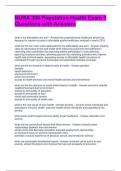NURA 306 Population Health Exam 1
Questions with Answers
what is the affordable care act? - Answer-the comprehensive healthcare reform law
designed to improve access to affordable quality healthcare; enacted in march 2010
what are the four main areas addressed by the addordable care act? - Answer-creating
value by decreasing errors and waste while improving outcomes and satisfaction
improving care coordination by improving patient participation in care planning,
spanning locations and time; reforming payment by rewarding providers who improve
health and minimize waste; expanding access to affordable health insurance for
individuals through insurance exchanges and expanded medicaid coverage
what are the six domains of determinants of health - Answer-genetics
heredity
health behaviors
physical environment
social environment
access to health services and overall health policies and interventions
what are the five domains or social determinants of health - Answer-economic stability
neighborhood and built environment
access to and quality of education
access to and quality of food
social and community context
access to and quality of health care.
what is the root cause of poor health - Answer-poverty. - poverty drives individuals and
populations into poor health, and poor health drives individuals and populations into
poverty
what social realms impact womens ability to get healthcare - Answer-education and
poverty
what are the sociocultural factors that affect women - Answer-unequal power
relationships between men and women
social norms that decrease education and paid employment opportunities
an exclusive focus on womens reproductive roles
potential or actual experience of physical, sexual, and emotional violence
what are sustainable development goals - Answer-universal call to action to end
poverty, protect the planet and improve the lives and prospects of everyone,
,everywhere. 17 goals covering a broad range of sustainable development issues for the
world, and an overarching aim is to address inequalities between and within nations.
161 targets
what SDG specifies health - Answer-3. good health and well being. ensure healthy lives
and promote well being for all at all ages
what are nursing interventions for SDGs - Answer-support development of healthcare
roles in countries that lack them
promote benefits of nursing as a distinct profession in health promotion and disease
prevention and reducing healthcare costs
work with govenments and other developers of policy to promote the rights of nurses
foster programs that promote enviornmental sustainability
act as mentor or consultant to address the health of individuals and communities in
other countries
two primary goals of healthy people 2030 - Answer-increase quality and years of
healthy life and eliminate any barriers to accessing healthcare, specifically by removing
health disparaties
what is primary prevention - Answer-maximize health and wellness, using a variety of
strategies, at a time when they or the clients have some level of control over the
trajectory of health and wellness.
what are examples of primary prevention - Answer-seatbelts, handwashing, proper
preparation of food, exercise, balanced nutrition, and immunizations
what are examples of conditions that are difficult for primary intervention - Answer-
genetic conditions, unexpected tragedies, and situations in which there is no
developmental control, such as the effect of second hand smoke.
what is secondary prevention - Answer-planned effort to minimize the impact of a
disease or injury once it is in effect
what is done in secondary prevention - Answer-the science of screening to make an
initial recognition of the stage of an illness or physical challenge, which can progress
either to greater or lesser severity over time.
what should nurses be aware of with screening - Answer-aware of tests limitations of
validity and reliability and to remember that serious economic costs to communities and
health systems can be incurred when testing is not accurate. aware of psychological
costs when a false positive result occurs, which can create debilitating fear and anxiety.
what is tertiary prevention - Answer-longterm management and treatment of clients with
chronic conditions, such as HIV/AIDS and cancer, so that quality of life is maintained,
, despite the fact that the condition will not improve and will most likely worsen.
rehabilatative and palliative care
what are tertiary prevention therapies - Answer-monitored exercise, stress
management, yoga and meditation, nutrtion counseling, smoking cessation, weight
management, and stress testing
what is the health belief model - Answer-individual, family, or community health related
behavior depends on the severity of th epotential illness or pysical challenge, the level
of conceivable susceptibility, the benefits of taking preventative action, and what stands
in the way of taking action toward the goal of health promotion
examples of health belief model - Answer-dont overdo it at dinner. lets try to do one
thing tonight that is not related to tv. got milk billboard in neighborhood
what is transtheoretical model - Answer-sequential approach to behavior change that
involves timely readiness of learner
what are social determinants of health - Answer-conditions in the environments in which
people are born, live, learn, work, play, worship, and age that affect a wide range of
health, functioning, and quality of life outcomes and risks
what influences SDOH - Answer-social norms, social and economic policies, and
political systems that affect the distribution of money, power, and resources.
what are examples of SDOH - Answer-income, education quality and attainment,
employment options and job security, working life conditions, neighborhood conditions,
food security, housing, social norms and attitudes, early childhood development, social
support, structural conflict, access to affordable quality health services, access to mass
media and technology,
what are the five domains of SDOH - Answer-education access and quality, economic
stability, social and community cohesion, neighborhood and built environment, and
healthcare access and quality.
what are the essential public health services in policy development - Answer-
communicate effectively to inform and educate
strengthen, support, and mobilize communities and partnerships
create, champion, and implement policies, plans and laws
utilize legal and regulatory actions
what are the essential public health assurances - Answer-enable equitable access
build a diverse and skilled work force
improve and innovate through evaluation, research, and quality improvement
build and maintain a strong organizational infrastructure for public health




